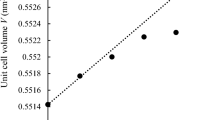Abstract
The theoretical equations governing the crystal-vapor equilibrium for Hg1−x Cdx Te(s) are summarized for a model with doubly-ionized native defects and applied to the data for x = 0.20, 0.40, and 1. The basic equations (Eq. (1) or (19)) are shown to contain those used elsewhere as special cases. Allowing the intrinsic carrier concentration, n1, to vary, but under constraints, to obtain an optimum fit and assuming a non-degenerate semiconductor, the hole con-centration-mercury pressure isotherms can be fitted satis-factorily and better than before with standard deviations between 22 and 24% for x = 0.20 and 0.40. A number of sets of model parameters give these fits, some of which give values as large as 10/cm at 500δC for the square root of the Schottky constant for ionized vacancies. In agreement with experiment, each of these parameter sets for x = 0.20 and 0.40 predicts a negligible dependence of the 77 and 192 K Hall mobilities upon equilibration temperature and predicts that metal saturation between 250 and 300δC with foreign donors in the 1015/cm3 range will result in elec-tron concentrations in the same range and dependent on saturation temperature to less than 26%. The enthalpy to create a “Hg-vacancy” and two holes is an invariant of the fits and is 2.00 ± 0.04 eV for x = 0.40 and 1.94 ± 0.02 eV for x = 0.20. Then ni is calculated independently assuming a parabolic valence band and a Kane conduction band. With an exact density of states for the latter obtained here, the momentum matrix element, P = 8.5 × 10−8 eV-cm, the spin-orbit splitting, Δ = 1 eV, and E (x, T) from Hansen et al., the experimental values below 300 K for 0 ≤x = 0.3 and at high temperature for x = 1 are fitted well with m ∗h /m = 0.70. With these independently calculated values for ni the electron concentration-cadmium pressure isotherms for CdTe can be fitted to about 7% for either of two incon-sistent data sets assuming 2 × 1016 /cm3 foreign donors. However data for x = 0.40 can be fitted to only 42% and that for x = 0.20, which is degenerate, to only 28%.
Similar content being viewed by others
References
E. O. Kane, J. Phys. Chem. Solidsl1, 249 (1957).
J. L. Schmit, J. Appl. Phys.41, 2876 (1970).
J. L. Schmit and E. L. Stelzer, J. Electron. Mater.7, 65 (1978).
J. P. Schwartz, Tse Tung, and R. F. Brebrick, J. Electrochem. Soc.128, 438 (1981).
R. F. Brebrick and J. P. Schwartz, J. Electron. Mater.9, 485 (1980).
W. Scott, E. L. Stelzer, and R. J. Hager, J. Appl. Phys.47, 1408 (1976).
H. R. Vydyanath, J. C. Donovan, and D. A. Nelson, J. Electrochem. Soc.128, 2625 (1981).
H. R. Vydyanath, J. Electrochem. Soc.128, 2609 (1981).
R. A. Reynolds, M. J. Brau, H. Kraus, and R. T. Bate, “The Physics of Semimetals and Narrow Gap Semiconductors” Eds. D. L. Carter and R. T. Bate, Pergamon Press, Oxford (1971).
F. T. J. Smith, Met. Trans.1, 617 (1970).
S. S. Chern, H. R. Vydyanath, and F. A. Kroger, J. Solid State Chem.14 33 (1975).
R. F. Brebrick in “Progress in Solid State Chemistry” Vol. 3, Editor, H. Reiss, Pergamon Press, Oxford (1966).
R. F. Brebrick, J. Solid State Chem.1, 88 (1969).
T. C. Harman and A. J. Strauss, J. Electron. Mater.5, 621 (1976).
R. F. Brebrick, J. Electron. Mater.6, 659 (1977).
R. F. Brebrick, J. Phys. Chem. Solids40, 177 (1979).
G. L. Hansen, J. L. Schmit, and T. N. Casselman, J. Appl. Phys.53, 7099 (1982).
M. H. Weiler, Vol. 16 of “Semiconductors and Semimetals,” Eds. R. K. Willardson and A. C. Beer, Academic Press, New York, (1981).
G. L. Hansen and J. L. Schmit, J. Appl. Phys.54, 1639 (1983).
W. Ehrenberg, Proc. Phys. Soc.(A) 63, 75 (1950).
J. Singer, “Elements of Numerical Analysis,” p. 273, Academic Press, N.Y. (1964).
Tse Tung, Ching-Hua Su, Pok-Kai Liao, and R. F. Brebrick, J. Vac. Sci. and Tech.21, 117 (1982).
J. A. Neider and R. Mead, Computer J.7, 308 (1965).
H. Rodot, M. Rodot, and M. Triboulet, Compte Rend.256, 5535 (1963).
J. Stankiewicz and W. Giriat, Phys. Rev.B13, 665 (1976).
E. Z. Dzuiba, Phys. Stat. Sol.62, 307 (1974).
C. Verie, Phys. Stat. Sol.17, 889 (1966).
H. B. Bebb and C. R. Ratliff, J. Appl. Phys.42, 3189 (1971).
H. Ehrenreich, J. Phys. Chem. Solids2, 131 (1957).
R. Dornhaus and G. Nimtz, Springer Tracts in Modern Physics, Vol. 78, Springer-Verlag, Berlin (1976).
C. Z.van Doom and D. de Nobel, Physica22, 338 (1956).
R. F. Brebrick, J. Electrochem. Soc.118, 2014 (1971).
T. N. Casselman, J. Appl. Phys. ul52, 848 2619.
H. R. Vydyanath,J. Electrochera. Soc. 128, 2619 1981.
Y. Nemirovsky and E. Finkman, J. Appl. Phys.50, 8107 (1979).
C. T. Elliott, J. Phys.D 4, 697 (1971).
Author information
Authors and Affiliations
Rights and permissions
About this article
Cite this article
Su, CH., Liao, PK. & Brebrick, R.F. Defect chemistry and intrinsic carrier concentration for Hg1−x Cdx Te(s) for x = 0.20, 0.40, and 1.0. J. Electron. Mater. 12, 771–826 (1983). https://doi.org/10.1007/BF02655295
Received:
Issue Date:
DOI: https://doi.org/10.1007/BF02655295



